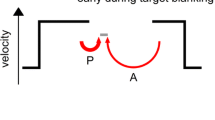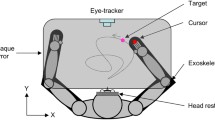Abstract
To date, smooth pursuit eye movement in schizophrenia has only been investigated using a target stimulus in continuous motion. However, smooth pursuit can also be evoked by an oscillating jumping dot that appears to be in apparent motion and although there is no continuous motion on the retinal surface this apparently moving stimulus can effortlessly elicit smooth-pursuit eye movement. In the first of two experiments smooth pursuit eye movement was evoked by target stimuli in continuous (real) motion at seven target velocities from 5.0 to 35.0 deg/s, and in a second experiment it was measured in response to an oscillating jumping dot in apparent motion at eight target velocities from 5.0 to 25.0 deg/s in a group with mixed-symptoms in schizophrenia and in a control group. The results of Experiment 1 provided no evidence for a dysfunction in continuous motion evoked smooth pursuit eye movement in the group with schizophrenia. However, following the removal of saccadic eye movements in smooth pursuit, the group with schizophrenia showed significantly lower smooth pursuit eye velocity at target velocities from 20.0 to 35.0 deg/s. The results of Experiment 2 revealed that apparent motion evoked smooth pursuit eye velocity in the group with schizophrenia was significantly lower in comparison with normal observers at all target velocities up to 25.0 deg/s with the inclusion or exclusion of saccadic eye movements. The findings demonstrate that overall smooth pursuit eye movement evoked in response to a continuous (real) motion target in the group with schizophrenia may nevertheless contain a hidden temporal resolution and integration dysfunction that is revealed when smooth pursuit eye movement is evoked in response to an oscillating jumping dot in apparent motion. The findings also demonstrate that normal smooth pursuit eye movement in normal observers can be made to resemble the dysfunctional smooth pursuit eye movement that is naturally found in some people with schizophrenia by using a target stimulus in apparent motion.




Similar content being viewed by others
References
American Psychiatric Association. (1992) Diagnostic and statistical manual of mental disorders, 4th edn. American Psychiatric Association, Washington
Andreasen NC (1981) Scale for the assessment of negative symptoms (SANS). University of Iowa, Iowa City
Andreasen NC (1983) Scale for the Assessment of Positive symptoms (SANS). University of Iowa, Iowa City
Anderson SJ, Drosdo N, Thompson CM (1995) Parvocellular neurons limit motion acuity in human peripheral vision. Proc R Soc Lond B 261:129–138
Balogh DW, Merritt RD (1987) Visual masking and the schizophrenia spectrum: interfacing clinical and experimental methods. Schizophr Bull 13:679–698
Barnes GR, Asselman PT (1992) Pursuit of intermittently moving targets in the human. J Physiol 445:617–637
Barnes GR, Schmit A (2002) Sequence learning in human ocular smooth pursuit. Exp Reain Res 144:322–335
Becker W, Fuchs AF (1985) Prediction in the oculomotor system: Smooth pursuit during transient disappearance of a visual target. Exp Brain Res 57:562–575
Benitez JT (1970) Eye-tracking and optokinetic tests: diagnostic significance in peripheral and central vestibular disorders. The Laryngoscope 80:834–848
Braff DL (1981) Early information processing deficit in schizophrenia. Arch Gen Psychiatry 38:175–179
Braff DL (1989) Sensory input deficits and negative symptoms in schizophrenia patients. Am J Psychiatry 146:1006–1011
Braff DL, Saccuzzo DP (1982) Effects of antipsychotic medication on speed of information processing in schizophrenic patients. Am J Psychiatry 139:1127–1130
Braff D, Saccuzzo DP (1985) The time-course of information processing deficits in schizophrenia. Am J Psychiatry 142:170–174
Chen Y, Levy DL, Nakayama K, Matthysse S, Palafox GP, Holzman PS (1999a) Dependence of impaired eye tracking on deficient velocity discrimination in schizophrenia. Arch Gen Psychiatry 56:155–161
Chen Y, Palafox GP, Nakayama K, Levy DC, Matthysse S, Holzman PS. (1999b) Motion perception in schizophrenia. Arch Gen Psychiatry 56:149–154
Churchland MM, Lisberger SG (2000) Apparent motion produces multiple deficits in visually guided smooth pursuit eye movements in monkeys. J Neurophysiol 84:216–235
Ciuffreda KJ, Tannen B (1995) Eye movement basics for the clinician. Mosby, St Louis
Clementz BA, Sweeney JA (1990) Is eye movement dysfunction a biological marker for schizophrenia? A methodological review. Psychol Bull 108:77–92
De Valois RL, Cottaris NP, Mahon LE, Elfar SD (2000) Spatial and temporal receptive fields of geniculate and cortical receptive fields and directional selectivity. Vis Res 40:3685–3702
Diefendorf AR, Dodge R (1908) An experimental study of the ocular reactions of the insane from photographic records. Brain 31:451–489
Dukelow SP, DeSouza JF, Culham JC, Van Den Berg AV, Menon RS, Tutis V (2001) Distinguishing subregions of human MT+ complex using visual fields and pursuit eye movements. J Neurophys 86:1991–2000
Edwards M, Badcock DR (1996) Global motion perception: interaction of chromatic and luminance signals. Vis Res 36:2423–2431
Ganz L (1975) Temporal factors in vision. In: Carterette FC, Friedman MP (eds) Handbook of perception, Vol 5 Seeing. Academic, New York
Green M, Walker E (1986) Symptom correlates of vulnerability to backward masking in schizophrenia. Am J Psychiatry 143:181–186
Hain T (1995) Real-Time Experimentation Platform (REX) Program Documentation. Northwestern University, 645 N. Michigan, Suite 1085; Chicago
Holzman PS, Proctor LR, Hughes DW (1973) Eye tracking patterns in schizophrenia. Science 181:179–181
Hutton S, Kennard C (1998) Oculomotor abnormalities in schizophrenia. Neurology 50:604–609
Iacono WG, Tuason VB, Johnson RA (1981) Dissociation of smooth-pursuit and saccadic eye tracking in remitted schizophrenics: an ocular reaction time task that schizophrenics perform well. Arch Gen Psychiatry 38:991–996
Iacono WG (1988) Eye movement abnormalities in schizophrenic and affective disorders. In: Johnston CW, Pirozollo FJ (eds) Neuropsychology of eye-movements. Lawrence Erlbaum, New York
Ikeda M, Boynton RM (1965) Negative flashes, positive flashes and flicker examined by the incremental threshold technique. J Opt Soc Am 55:560–566
Katcher BS, Young LY, Koda-Kimble MA (1988) Applied therapeutics: the clinical use of drugs, 4th edn. Applied Therapeutics, Vancouver
Katsanis J, Iacono W (1991) Clinical, neuropsychological, and brain structure correlates of smooth pursuit eye movement performance in chronic schizophrenics. J Abn Psychol 100:526–534
Kay SR, Opler LA, Fiszbein A (1991) Positive and negative syndrome scale. Multi-Health Systems, Inc. 908 Niagara Falls Boulevard, North Tonawanda, New York
Keefe R, Siever L, Mohs R, Peterson AE, Mahon TR, Berman RL, Davis KL (1989) Eye tracking, schizophrenic symptoms, and schizotypal personality disorder. Eur Arch Psychiatr Neurol Sci 239:39–42
Kelly P, Rennie C, Gordon E, Anderson J, Howson A, Meares R (1990) Smooth pursuit eye tracking dysfunction and negative symptoms in schizophrenia. Psychiatr Res 34:89–97
Knight RA, Sims-Knight JE (1980) Integration of visual patterns in schizophrenia. J Abnormal Psychol 89:623–634
Kowler E, Steinman RM (1979) The effect of expectation on slow oculomotor control. I. Periodic target steps. Vis Res 19:633–646
Kuechenmeister CA. Linton PH, Meuller TV, White HB (1977) Eye tracking in relation to age, sex, and illness. Arch Gen Psychiatry 34:578–599
Lamontagne C (1973) A new experimental paradigm for the investigation of the secondary system of human visual motion perception. Perception 2:167–180
Legge G (1987) Sustained and transient mechanisms in human vision: temporal and spatial properties. Vis Res 18:69–81
Leigh RJ, Zee DS (1999) The neurology of eye movements. Oxford University Press, New York
Levin S, Lipton RB, Holzman PS (1981). Pursuit eye movements in psychopathology: effect of target characteristics. Biol Psychiatry 16:255–267
Levy DL, Holzman PS, Matthysse S, Mendell NR (1993) Eye tracking dysfunction in schizophrenia: a critical perspective. Schizophr Bull 19:461–535
Levy DL, Lajonchere CM, Dorogusker B, Lieberman JA, Mendell NR. (2000) Quantitative characterization of eye tracking dysfunction in schizophrenia. Schizophr Res 42:171–185
Lisberger SG, Morris EJ, Tychsen L (1987) Visual motion processing and sensory motor integration for smooth pursuit eye movement. Ann Rev Neurosci 10:97–129
Macavoy MG, Bruce CJ (1995) Comparison of the smooth eye movement tracking disorder of schizophrenics with that of non-human primates with specific brain lesions. Int J Neurosci 80:117–151
Mather JA, Putchat C (1982–1983) Motor control of schizophrenics-I. Oculomotor control of schizophrenics: a deficit in sensory processing, not strictly in motor control. J Psychiatr Res 17:343–360
Morgan MJ, Turnbull DF (1978) Smooth eye tracking and the perception of motion in the absence of real movement. Vis Res 18:1050–1059
Nachmias J (1967) Effect of exposure duration on visual contrast sensitivity with square-wave gratings. J Op Soc Am 57:421–427
Nagel M, Sprenger A, Zapf S, Erdmann C, Kompf D, Heide W, Binkofski F, Lencer R (2005) Parametric modulation of cortical activation during smooth pursuit with and without target blanking. An fMRI study. NueroImage 29:1319–1325
Nelson HE (1983) National adult reading test (NART). Nfer-Nelson Publishing Co, Windsor
O’Driscoll GA, Benkelfat C, Florencio PS, Wolff AV, Joober R, Lal S, Evans AC (1999) Neural correlates of eye tracking deficits in first-degree relatives of schizophrenic patients. Arch Gen Psychiatry 56:1127–1134
Rashbass C (1961) The relationship between saccadic and smooth tracking eye movements. J Physiol 159:326–338
Reulen JPH, Marcus JT, Koops D, De Vries FR, Tiesinga G, Boshuizen K, Bos JE (1988) The precise recording of eye movement, the IRIS technique, part 1. Med Biol Eng Comp 26:20–26
Robinson DA (1965) The mechanisms of human smooth pursuit eye movement. J Physiol 180:569–591
Roitman SEL, Keefe RSE, Harvey PD, Siever LJ, Mohs RC (1997) Attentional and eye tracking deficits correlate with negative symptoms in schizophrenia. Schizophr Res 26:139–146
Ross DE, Ochs AL, Goldberg SC, Pandurangi AK, Kendler KS (1988) Abnormal oscillations in the slow pursuit eye movement of schizophrenic patients (abstract). Schiz Res 2:91
Ross DE, Thaker G.K, Buchanan RW, Kirkpatrick B, Lahti AC, Medoff D, Bartko JJ, Goldman J, Tien A (1997). Eye tracking disorder in schizophrenia is characterised by specific ocular motor deficits and is associated with the deficit syndrome. Biol Psychiatry 42:47–62
Slaghuis WL, Bakker VJ (1995) Forward and backward masking of contour by light in positive- and negative symptom schizophrenia. J Abnorm Psychol 104:41–54
Slaghuis WL, Curran C (1999) Spatial frequency masking in positive- and negative-symptom schizophrenia. J Abnorm Psychol 108:42–50
Slaghuis WL, Bishop AM (2001) Luminance flicker sensitivity in positive- and negative-symptom schizophrenia. Exp Brain Res 138:88–99
Slaghuis WL, Thompson A (2003) The effect of peripheral visual motion on contrast sensitivity in positive- and negative-symptom schizophrenia. Neuropsychologia 41:968–980
Slaghuis WL (2004) Spatio-temporal luminance contrast sensitivity and visual backward masking in schizophrenia, Exp Brain Res 156:196–211
Slaghuis WL, Bowling AC, French R (2005) Linear smooth pursuit eye movement and directional motion contrast sensitivity in positive- and negative-symptom schizophrenia. Exp Brain Res 166:89–101
Slaghuis WL, Holthouse T, Hawkes A, Bruno R (2007) Eye movement and visual motion perception in schizophrenia II: global coherent motion as a function of target velocity and stimulus density. Exp Brain Res (in press). doi:10.1007/s00221-007-1003-3
Schuck JR. Lee RG (1989) Backward masking, information processing, and schizophrenia. Schizophr Bull 15:491–500
Stuve TA, Friedman L, Jesberger JA, Gilmore GC, Straus ME, Meltzer HY (1997) The relationship between smooth pursuit performance, motion perception and sustained visual attention in patients with schizophrenia and normal controls. Psychol Med 27:143–152
Tychsen L, Lisberger SG (1986) Maldevelopment of visual motion processing in humans who had strobismus with onset of infancy. J Neurosci 6:2495–2508
Wertheim AH, Van Gelder P, Peselow LE, Cohen N (1985) High thresholds for movement perception in schizophrenia may indicate abnormal extraneous noise levels of central vestibular activity. Biol Psychiatry 20:1197–1210
Westheimer G (1954) Eye movement responses to a horizontally moving visual stimulus. Arch Ophthalmol 52:932–941
Woodhouse JM, Barlow HB (1982) Spatial and temporal resolution and analysis. In: Barlow HB, Mollon JD (eds) The senses. Cambridge University Press, London, pp 133–164
Acknowledgment
We gratefully acknowledge the cooperation of the Tasmania Department of Health Division of Psychiatry, and all observers who participated willingly and generously to this study. This project was supported by an IRGS grant from the University of Tasmania in 2000.
Author information
Authors and Affiliations
Corresponding author
Rights and permissions
About this article
Cite this article
Slaghuis, W.L., Hawkes, A., Holthouse, T. et al. Eye movement and visual motion perception in schizophrenia I: Apparent motion evoked smooth pursuit eye movement reveals a hidden dysfunction in smooth pursuit eye movement in schizophrenia. Exp Brain Res 182, 399–413 (2007). https://doi.org/10.1007/s00221-007-1000-6
Received:
Accepted:
Published:
Issue Date:
DOI: https://doi.org/10.1007/s00221-007-1000-6




